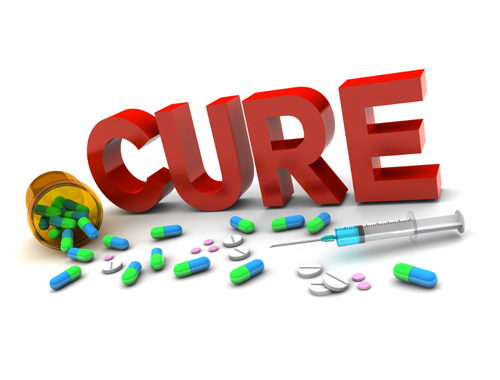Difference Between Cure and Treatment
A cure is when an illness or disorder is completely fixed. Treatment is the management of an ailment to reduce symptoms and is a way to try to achieve a cure.

What is a Cure?
Definition:
A cure is when a medical condition is completely resolved.
Methods:
Medication and surgery can help bring about a cure for certain medical problems.
Examples:
Appendicitis and cholecystitis can be cured because the affected organ is surgically removed. More minor conditions such as a mole on the skin can also be surgically excised.
Future methods:
Research into nanotechnology and gene therapy suggests these may be used to cure currently incurable illnesses. Nanotechnology using gold particles can potentially cure bacterial infections. Gene therapy is being investigated as a possible cure for HIV.

What is Treatment?
Definition:
Treatment is a way to help alleviate symptoms of a condition and is a way to attempt to manage or cure a medical condition.
Methods:
There are many procedures that can be used to treat medical problems and diseases. Lifestyle changes and medication is often the first choice for many disorders such as diabetes and high blood pressure. In the case of cancer, there are a variety of options including chemotherapy, radiation, immunotherapy, and surgery.
Examples:
Many ailments are not curable but treatable. Diabetes and hypertension are not curable but they can be managed through diet, exercise, and medicine. Cancer is a cluster of illnesses that are not curable. However, a person can go into remission, which is where the signs of illness are reduced. Many doctors do not consider this a total cure.
Future methods:
New ways to treat problems like cancer are always being researched. Smart drug delivery using nanotechnology systems is one idea that researchers have to reduce the severe side effects of chemotherapy. Stem cell transplants are a potential treatment for diabetes. The concept is that islet cells could be transplanted into the pancreas as a replacement for cells that are not functioning.
Difference between Cure and Treatment?
Definition
A cure is when health is restored after a health problem. Treatment is when some type of method is used to ameliorate a medical condition and help ease symptoms.
Methods
A cure can be achieved with surgery in some cases. There are many treatment methods available including medication, chemotherapy, radiation, immunotherapy, and surgery.
Examples
Two examples of conditions that can be cured are cholecystitis and appendicitis. Examples of some of the conditions that are treatable include cancer, HIV, hypertension, and diabetes.
Future methods
Nanotechnology and gene therapy may in the future, cure certain disorders. Nanocarriers and stem cell therapy may be used in the future to treat some medical problems.
Benefits
A cure restores a person’s health. Treatments help alleviate symptoms.
Disadvantages
To bring about a cure an organ may need to be removed. Treatments may not bring about a cure and may be needed long-term.
Table comparing between Cure and Treatment

Summary of Cure Vs. Treatment
- A cure is when an individual’s health is restored because their medical condition is resolved.
- A treatment is some type of method used to treat signs of an ailment and try to achieve a cure.
- Many medical conditions are not curable but can be managed through treatment methods.
FAQ
What is the difference between curable and treatable?
An illness that is curable is one that can be treated and the health of the person restored with low chance of a return of the condition. A treatable illness can be managed via various methods but often the actual condition remains although symptoms may be minimized.
What is considered a cure?
A cure is a complete recovery with no chance of recurrence of an illness. A cure is rare but can be achieved in some cases by surgical intervention.
Which disease has no cure?
Many diseases cannot be completely cured and only managed. For instance, diabetes, high blood pressure, and cancer.
What is the difference between cure and recovery?
A cure is when total recovery has happened (i.e., health is restored). Recovery is the process of getting better from an illness.
What does it mean if something is treatable but not curable?
Treatment can extend life and improve the quality of life. Many autoimmune conditions such as type I diabetes are not curable since the problem is with the person’s own immune system.
What makes a disease incurable?
It depends on the disease as to why it is incurable. Metastatic cancer is an example, and is incurable because the cancer cells are widespread meaning that treatment may extend life but will not save it.
Does Ebola have a cure?
There is no specific cure for Ebola as yet. Since this is a viral disease, it is difficult to treat. An Ebola vaccine called rVSV-ZEBOV was developed in 2019 but is yet to be approved.
Does diabetes have a cure?
No, diabetes cannot be cured regardless of the type of diabetes. Diabetes is an example where insulin levels can be managed but the person will always have this problem, and cannot be cured.
- Difference Between Constipation and Bowel Obstruction - April 3, 2024
- Difference Between Constipation and Diarrhea - March 30, 2024
- Difference Between Cellulite and Stretch Marks - March 25, 2024
Search DifferenceBetween.net :
Leave a Response
References :
[0]Batten, Jason N., et al. "What does the word “treatable” mean? Implications for communication and decision-making in critical illness." Critical care medicine 47.3 (2019): 369.
[1]Li, Juanjuan, et al. "Gold nanoparticles cure bacterial infection with benefit to intestinal microflora." Acs Nano 13.5 (2019): 5002-5014.
[2]Peterson, Christopher W., and Hans-Peter Kiem. "Cell and gene therapy for HIV cure." HIV-1 latency (2017): 211-248.
